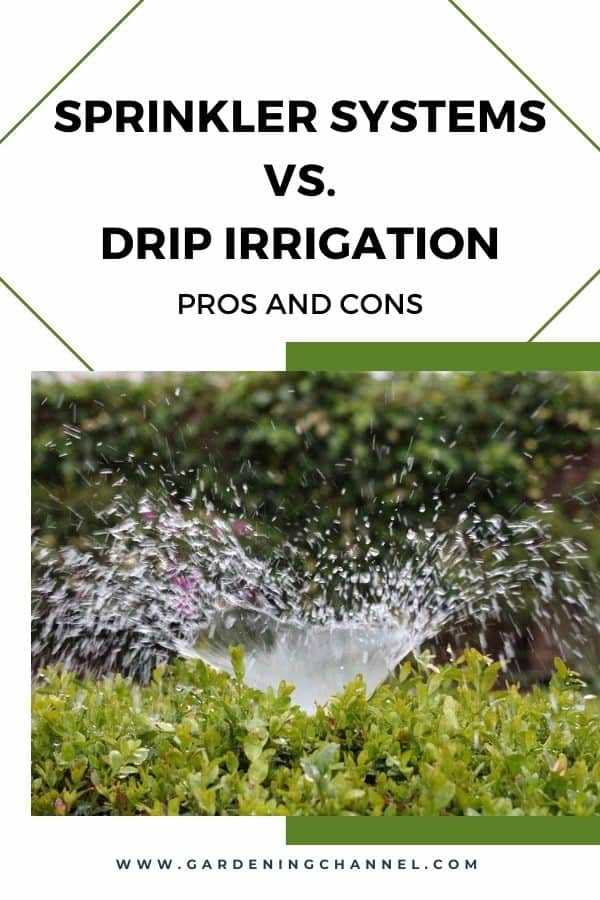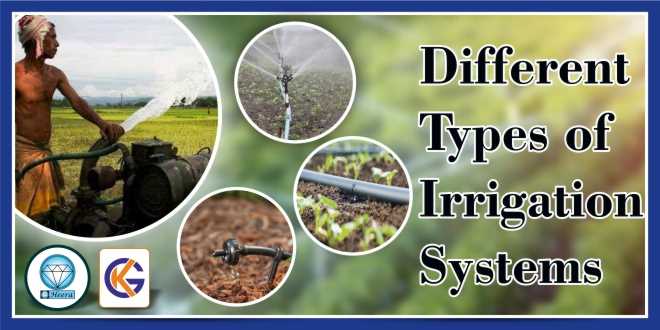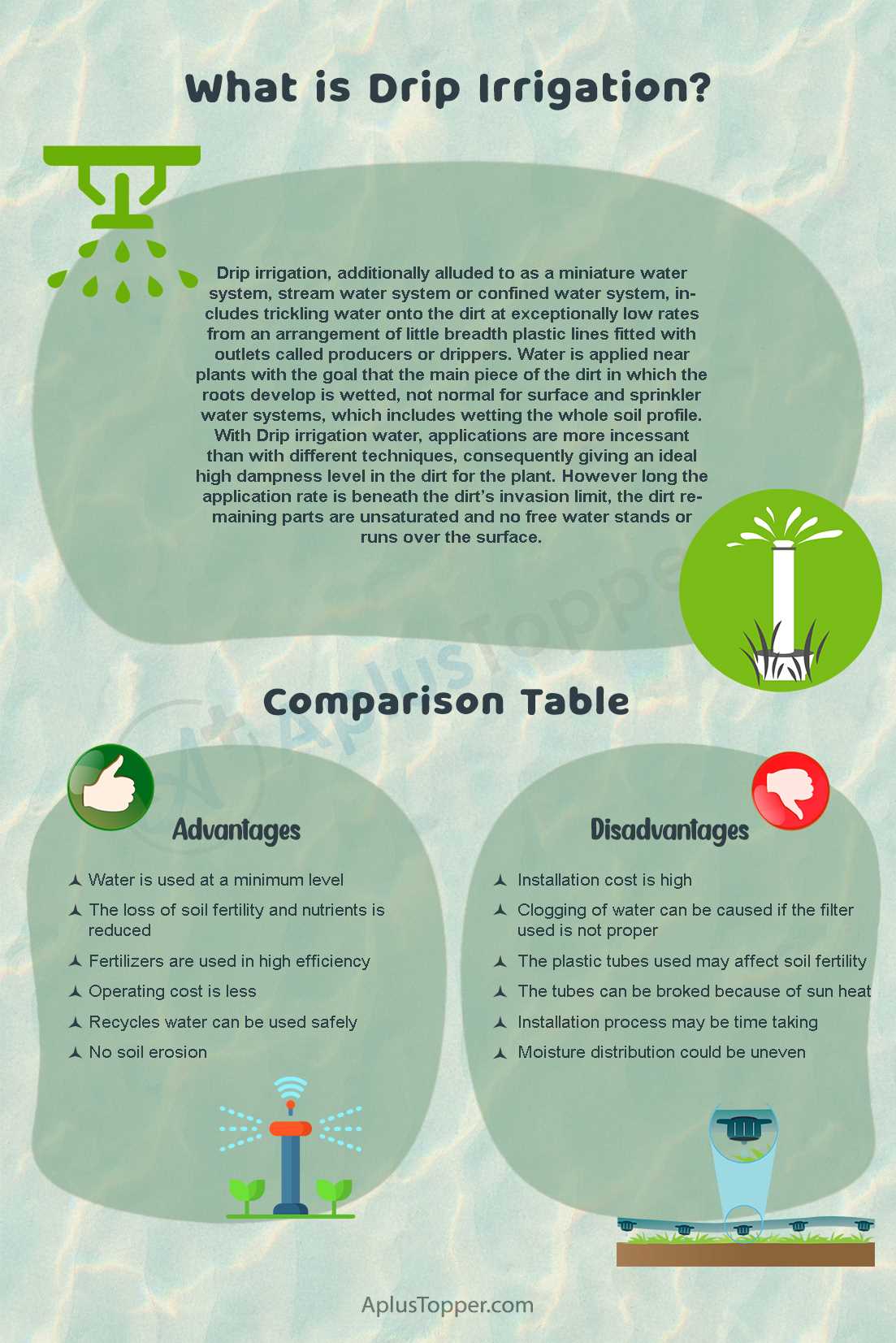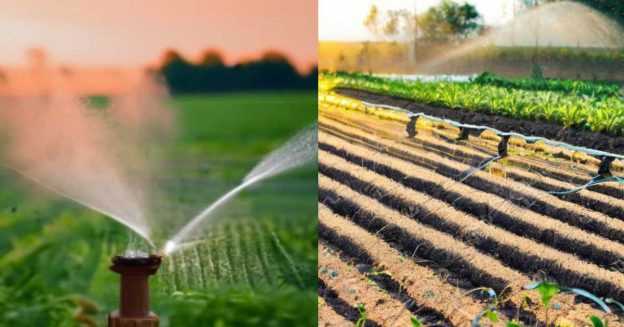- The Advantages of Sprinkling, Drip, and Deep Watering Methods
- Sprinkling Method Advantages
- Drip Method Advantages
- Deep Watering Method Advantages
- Efficient Water Distribution
- Conserves Water
- Reduces Evaporation
- Helps Prevent Diseases
- The Disadvantages of Sprinkling, Drip, and Deep Watering Methods
- Increased Weed Growth
- Risk of Overwatering
- 1. Root Rot
- 2. Nutrient Leaching
- 3. Disease and Pest Problems
- 4. Reduced Oxygen Availability
- 5. Wasting Water and Resources
- Expensive Installation
- Requires Regular Maintenance
- Question-answer:
- What are the advantages of sprinkling watering method?
- What are the disadvantages of sprinkling watering method?
- What are the advantages of drip watering method?
- What are the disadvantages of drip watering method?
- What are the advantages of deep watering method?
- What are the disadvantages of deep watering method?
- Which watering method is best for small gardens?
- Video: Advantages and Disadvantages of Drip Irrigation System
Sprinkling, drip, and deep watering are three common methods used for irrigating plants and crops. Each method has its own advantages and disadvantages, and choosing the right method for a specific situation can greatly impact the success of the irrigation process.
Sprinkling: Sprinkling is a popular method of watering that involves spraying the water directly onto the plants or soil. One major advantage of sprinkling is its ability to cover a large area quickly and effectively. It is also a flexible method that can be easily adjusted to meet the specific needs of different plants and soil conditions. However, sprinkling can be wasteful, as much of the water may be lost to evaporation or runoff. Additionally, the water droplets can cause soil compaction and erosion.
Drip: Drip irrigation is a method that delivers water directly to the plants’ roots through a network of tubes and emitters. This method has several advantages, including water conservation and reduced weed growth. Drip irrigation also allows for more precise control over the amount and timing of water delivered to each plant. However, the initial setup and maintenance costs of drip irrigation systems can be higher than other methods. It also requires proper monitoring and maintenance to prevent clogging of the emitters and ensure efficient water delivery.
Deep Watering: Deep watering involves applying a large volume of water directly to the root zone of plants. This method encourages deep root growth and helps plants become more resilient to drought. Deep watering can also reduce water loss from evaporation and runoff. However, it can be time-consuming and labor-intensive, especially for large-scale irrigation. It is also important to ensure that the water penetrates deep into the soil and does not accumulate near the surface, which can lead to shallow rooting and plant stress.
In conclusion, each watering method has its own advantages and disadvantages. The choice of which method to use depends on factors such as the specific watering requirements of the plants, the size and layout of the area to be irrigated, and the availability of resources such as water and labor. By carefully considering these factors and weighing the pros and cons of each method, growers and gardeners can make informed decisions to achieve optimal irrigation results.
The Advantages of Sprinkling, Drip, and Deep Watering Methods
Sprinkling Method Advantages

- Sprinkling provides uniform coverage of water over a large area, ensuring that all plants receive an adequate amount of moisture.
- This method is efficient in terms of water usage as it reduces runoff and evaporation.
- Sprinkling can help cool down plants during periods of hot weather, preventing stress and damage.
- It is easy to set up and can be automated using timers, making it convenient for gardeners and farmers.
- Sprinklers can be adjusted to provide different spray patterns and coverage, allowing customization based on the needs of different plants.
Drip Method Advantages
- Drip irrigation delivers water directly to the base of plants, reducing water waste and minimizing the growth of weeds.
- This method is highly efficient in terms of water usage as it provides slow and precise watering, avoiding runoff and evaporation.
- Drip irrigation promotes healthier plant growth by delivering water and nutrients directly to the roots, minimizing moisture-related diseases and encouraging deep root development.
- It can be easily customized and adapted to the specific needs of different plants, allowing for better control over water and fertilizer delivery.
- Drip systems can be automated and controlled with timers, making it a convenient option for busy gardeners.
Deep Watering Method Advantages
- Deep watering ensures that the water penetrates deeply into the soil, reaching the root zone of plants.
- This method encourages deep root development, making plants more resistant to drought and capable of accessing nutrients from deeper soil layers.
- Deep watering reduces the frequency of watering, saving time and water in the long run.
- It promotes a more efficient usage of water as it minimizes evaporation and runoff.
- Deep watering can improve soil quality by encouraging beneficial microbial activity and nutrient cycling.
Overall, each watering method has its own advantages, and the choice of which method to use depends on the specific needs of the plants, climate conditions, and the gardener’s preferences.
Efficient Water Distribution
Efficient water distribution is a key factor to consider when choosing a watering method. It is important to ensure that water is effectively and evenly distributed throughout the plants’ root zones to maximize growth and minimize water wastage.
Sprinkling, drip, and deep watering methods each have their own advantages and disadvantages in terms of water distribution:
- Sprinkling: Sprinklers distribute water over a large area, making them suitable for watering lawns or gardens with shallow-rooted plants. However, sprinkling can lead to water loss due to evaporation and runoff, and some plants may not receive adequate water if they are located in the shadow of others.
- Drip: Drip irrigation systems deliver water directly to the plants’ root zones, minimizing water wastage and reducing the risk of evaporation. This method is especially useful for garden beds, potted plants, or areas with closely spaced plants. However, drip systems can become clogged, and it may be challenging to ensure even distribution of water to all plants.
- Deep watering: Deep watering involves saturating the soil to reach the plants’ deep root zones. This method promotes deep root development and helps plants withstand drought conditions. However, it requires more water and can lead to water wastage if not done properly. Additionally, it may not be suitable for plants with shallow root systems.
To ensure efficient water distribution, factors such as soil type, plant needs, and weather conditions should also be considered. Monitoring the moisture levels in the soil and adjusting the watering schedule accordingly can help optimize water distribution and promote healthy plant growth.
Conserves Water
The various methods of water delivery for plants have different levels of water conservation. Here are the advantages and disadvantages of each method:
- Sprinkler irrigation methods, such as overhead sprinklers, are known to waste a significant amount of water. This is because a portion of the water is lost to evaporation or carried away by wind before it can reach the plants’ roots.
- Drip irrigation is considered one of the most water-efficient methods of watering plants. It delivers water directly to the roots, minimizing water loss due to evaporation or runoff. Drip irrigation systems often have adjustable flow rates, allowing for precise control over the amount of water applied to each plant.
- Deep watering, or deep root watering, is another water-conserving approach. This method involves delivering water directly to the deep roots of plants, where it is most needed. Deep watering encourages plants to develop deep root systems, which can access water stored deep underground and reduce the overall amount of water needed.
Overall, both drip irrigation and deep watering methods are advantageous in terms of water conservation. They minimize water waste and ensure that plants receive the necessary amount of water without excess runoff or evaporation.
Reduces Evaporation
Drip and deep watering methods have an advantage over sprinkling when it comes to reducing evaporation. Due to the direct application of water to the root zone, drip and deep watering methods minimize the exposure of water to the air, thus reducing evaporation rates.
When using sprinklers, water is distributed over a larger area, increasing the surface area exposed to air. This can lead to higher evaporation rates, especially in dry and hot climates. In contrast, drip and deep watering methods deliver water directly to the plant roots, minimizing the opportunity for evaporation.
Reduced evaporation not only helps conserve water but also increases the efficiency of watering. With less water lost to evaporation, more of the water applied to the plants is absorbed and utilized by the roots, leading to improved plant health and growth.
Additionally, reducing evaporation can help prevent the formation of weeds. When water is sprayed over a larger area, it can moisten the soil surface, creating an ideal environment for weed growth. By minimizing evaporation through drip or deep watering, the soil surface remains drier, making it less favorable for weed germination and growth.
Helps Prevent Diseases
- One of the advantages of using the sprinkling, drip, and deep watering methods is that they can help prevent diseases in plants.
- When plants are watered using these methods, the water is typically applied directly to the roots, rather than being sprayed over the entire plant.
- This targeted watering approach reduces the amount of moisture on the leaves and stems, which can help prevent the spread of fungal or bacterial diseases.
- Many plant diseases thrive in wet conditions, so by minimizing the amount of water that comes into contact with the above-ground parts of the plant, these watering methods can help reduce the risk of disease development.
- Additionally, the use of drip irrigation, in particular, can further reduce the risk of disease transmission as the water is delivered directly to the soil surface, avoiding contact with the plant foliage altogether.
In contrast, traditional overhead sprinklers can create a wet and humid environment that is conducive to disease development.
By employing sprinkling, drip, or deep watering methods, gardeners and farmers can better protect their plants and promote overall plant health.
The Disadvantages of Sprinkling, Drip, and Deep Watering Methods
Sprinkling, drip, and deep watering methods all have their own advantages, but they also come with their fair share of disadvantages. Here are some drawbacks to consider:
- Water Waste: Sprinkling can lead to significant water waste. Due to evaporation, wind drift, and uneven distribution, a significant amount of water can be lost before it reaches the plants.
- Leaf Diseases: Sprinkling water directly onto the leaves of plants can increase the risk of leaf diseases. Excess moisture on the leaves can promote the growth of fungi and bacteria, leading to various diseases.
- Shallow Root Growth: Sprinkling and drip methods both tend to encourage shallow root growth. Since the water is applied near the surface, the roots may not grow deep enough to access water during dry periods. This can make plants more susceptible to drought stress.
- Weed Growth: Sprinkling can also promote weed growth. By watering the entire area, including the open spaces between plants, sprinklers can provide favorable conditions for weed growth, leading to competition for resources with desired plants.
- Equipment Maintenance: All watering methods require some level of equipment maintenance. Sprinklers can become clogged or broken, drip systems may require regular inspection for leaks or blockages, and deep watering may require digging holes or trenches, which can be labor-intensive.
- Cost: Some watering methods, such as drip irrigation or deep watering, require specialized equipment and installation, which can add to the overall cost. Sprinkling may also lead to higher water bills due to the excessive use of water.
- Dependence on Electricity: Sprinkling systems often require electricity to operate, which can be a disadvantage in areas with frequent power outages or limited access to electricity.
- Increased Disease Spread: Sprinkling can spread diseases by splashing contaminated soil or leaf surfaces onto healthy plants. Bacteria, fungi, and other pathogens can be transferred from one plant to another, increasing the risk of plant diseases.
Overall, while sprinkling, drip, and deep watering methods offer their own benefits in certain situations, it is important to consider their disadvantages and choose the watering method that best suits the specific needs and conditions of the plants and environment.
Increased Weed Growth

One potential disadvantage of using sprinkling, drip, or deep watering methods is an increased risk of weed growth.
When water is applied to the soil using these methods, it not only hydrates the desired plants but also provides moisture for weed seeds to germinate and grow. The widespread distribution of water through sprinklers or drip systems can create ideal conditions for weeds to thrive.
Additionally, these watering methods may not provide sufficient water directly to the plants’ root systems, which can lead to shallow root development. Shallow roots can make it easier for weeds to compete with the plants for available water and nutrients.
To minimize the risk of increased weed growth, gardeners can implement several strategies:
- Apply mulch around plants to suppress weed growth by blocking sunlight and reducing seed germination.
- Use weed barriers or landscape fabric to control weed growth in garden beds.
- Regularly hand-pull or hoe any emerging weeds before they can become established.
- Monitor soil moisture levels closely to avoid overwatering, as excessive moisture can also encourage weed growth.
By taking these proactive measures, gardeners can help prevent or minimize the negative effects of increased weed growth when using sprinkling, drip, or deep watering methods.
Risk of Overwatering

One of the disadvantages of all watering methods, including sprinkling, drip, and deep watering, is the risk of overwatering. Overwatering occurs when plants receive more water than they need, leading to various negative consequences.
1. Root Rot
Overwatering can lead to root rot, a condition in which the roots of plants become waterlogged and damaged. When the soil is constantly saturated with water, the roots are deprived of oxygen, preventing them from functioning properly. As a result, the roots rot, leading to a decline in plant health.
2. Nutrient Leaching
Excessive watering can cause nutrients to leach out of the soil. When plants are watered too frequently, the excess water washes away essential nutrients, such as nitrogen, potassium, and phosphorus, leaving the soil depleted. As a result, plants may suffer from nutrient deficiencies, which can negatively impact their growth and development.
3. Disease and Pest Problems

Overwatered plants are more susceptible to certain diseases and pests. Excess moisture creates a favorable environment for fungi and bacteria to thrive, leading to the development of diseases such as powdery mildew and root rot. Additionally, overwatered plants may attract pests such as snails and slugs, further compromising their health.
4. Reduced Oxygen Availability
Overwatering reduces the availability of oxygen for plant roots. When the soil is saturated, air pockets in the soil are filled with water, preventing the roots from accessing the oxygen they need for respiration. Without sufficient oxygen, the roots suffocate, hindering their ability to take up water and nutrients effectively.
5. Wasting Water and Resources
Overwatering not only harms plants but also wastes water and resources. Watering plants excessively consumes more water than necessary, wasting this valuable resource. Additionally, excessive watering can lead to increased runoff, which carries away nutrients from the soil and pollutes water sources.
Therefore, it is important to monitor the watering practices to avoid overwatering and its detrimental effects on plants and the environment. It is essential to water plants based on their specific needs, considering factors such as soil moisture levels, weather conditions, and plant types.
Expensive Installation
One of the main disadvantages of sprinkling, drip, and deep watering methods is the cost associated with their installation. These irrigation systems require a significant upfront investment, especially when compared to manual watering methods.
The installation of a sprinkler system involves laying pipes throughout the garden or lawn, installing sprinkler heads, and configuring the system to deliver water to specific areas. This process can be time-consuming and requires professional expertise for proper installation.
Drip irrigation systems, on the other hand, involve the installation of a network of narrow tubes or hoses that deliver water directly to the plant roots. This requires careful planning and precise installation to ensure proper water distribution and prevent leaks.
Deep watering methods, such as using a soaker hose or burying a pipe deep into the ground, also require careful installation to ensure efficient water delivery. This may involve digging trenches or burying the hose underground, which can be labor-intensive and require additional equipment.
Overall, the installation of sprinkling, drip, and deep watering methods can be expensive due to the cost of materials, professional installation, and any additional equipment or tools required. This cost should be considered when deciding on the most suitable watering method for your garden or lawn.
Requires Regular Maintenance
While all watering methods require some level of maintenance, some may require more attention than others.
Sprinkling:
- Sprinkler systems need to be regularly inspected for leaks, clogs, or damage to ensure they are functioning properly.
- Nozzles and sprinkler heads may need to be adjusted periodically to ensure even water distribution.
- Filters and screens need to be cleaned or replaced regularly to prevent clogging.
Drip Irrigation:
- Drip systems require regular inspection to check for leaks, breaks, or blockages in the tubing.
- Emitters may need to be cleaned or replaced if they become clogged.
- Filters and pressure regulators should be checked and cleaned to maintain the system’s efficiency.
Deep Watering:
- Deep watering methods, such as soaker hoses or deep root watering spikes, require regular monitoring to ensure the water is penetrating deep soils.
- Watering times may need to be adjusted depending on weather conditions and plant needs.
- Overwatering should be avoided, as it can lead to plant diseases or root rot.
Overall, the regular maintenance required for watering methods will vary depending on the specific system used and the needs of the plants being watered. It is important to regularly inspect and adjust the watering system to ensure optimal plant health and water efficiency.
Question-answer:
What are the advantages of sprinkling watering method?
One advantage of the sprinkling watering method is that it provides a even distribution of water over a large area. This method is also convenient and time-saving, as it does not require manually watering each plant. Additionally, sprinkling can help to cool down plants on hot days.
What are the disadvantages of sprinkling watering method?
One disadvantage of the sprinkling watering method is that it can lead to the wastage of water, as some of the water may be lost through evaporation or wind. Another disadvantage is that it can promote the spread of certain diseases, as the water droplets may carry pathogens from one plant to another.
What are the advantages of drip watering method?
One advantage of the drip watering method is that it delivers water directly to the plant’s roots, minimizing water wastage. This method also helps to provide a consistent moisture level for plants, which is beneficial for their growth. Drip watering can also reduce the risks of weed growth and the spread of diseases.
What are the disadvantages of drip watering method?
One disadvantage of the drip watering method is that it requires proper installation and maintenance, as clogged or damaged tubes can affect the water distribution. This method may also be more time-consuming, as it requires setting up a network of tubes for each plant. Additionally, drip watering may not be suitable for plants with shallow roots.
What are the advantages of deep watering method?
One advantage of the deep watering method is that it encourages plants to develop deep root systems, which can make them more resilient to drought conditions. This method also helps to promote better nutrient absorption, as the water penetrates deeper into the soil, reaching the plant’s roots. Deep watering can also reduce the risk of soil erosion.
What are the disadvantages of deep watering method?
One disadvantage of the deep watering method is that it requires a larger amount of water, as it aims to saturate the soil to a greater depth. This method may also be more time-consuming, as the water needs to penetrate the soil slowly to avoid runoff and ensure proper absorption. Additionally, deep watering may not be suitable for all plants, especially those with shallow root systems.
Which watering method is best for small gardens?
The best watering method for small gardens depends on various factors, such as the type of plants, soil type, and climate. However, drip watering is often recommended for small gardens, as it provides precise water delivery to each plant’s root zone, minimizing water wastage. It also helps to maintain a consistent moisture level, which is important for healthy plant growth.







